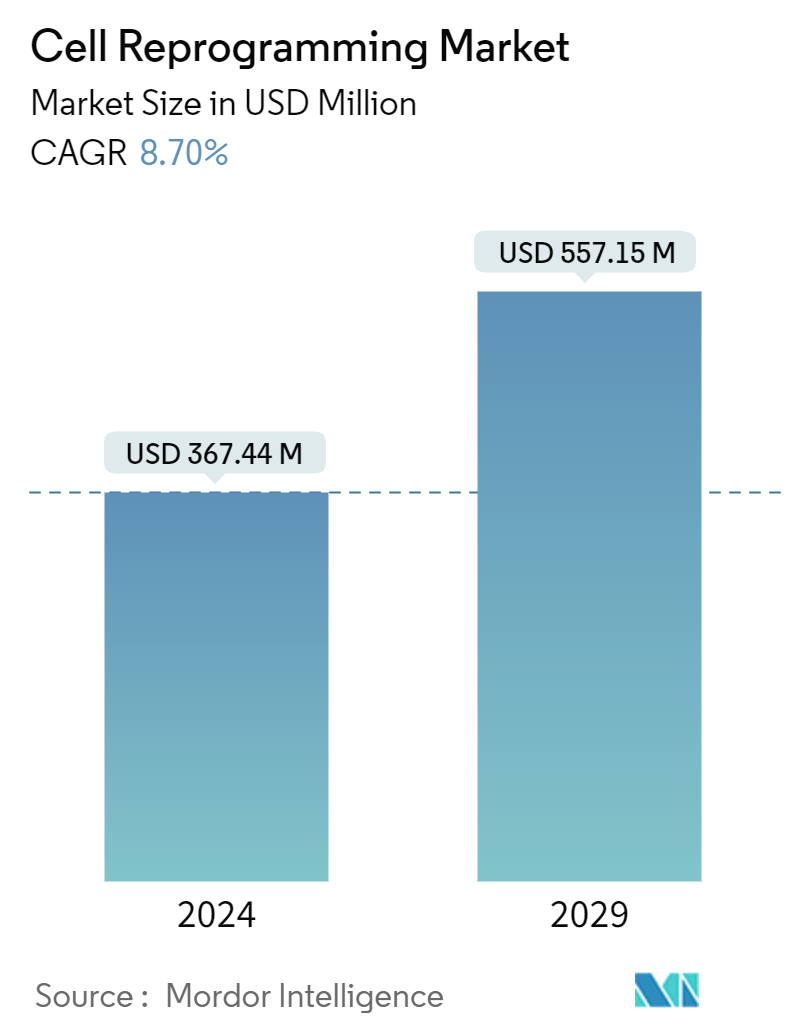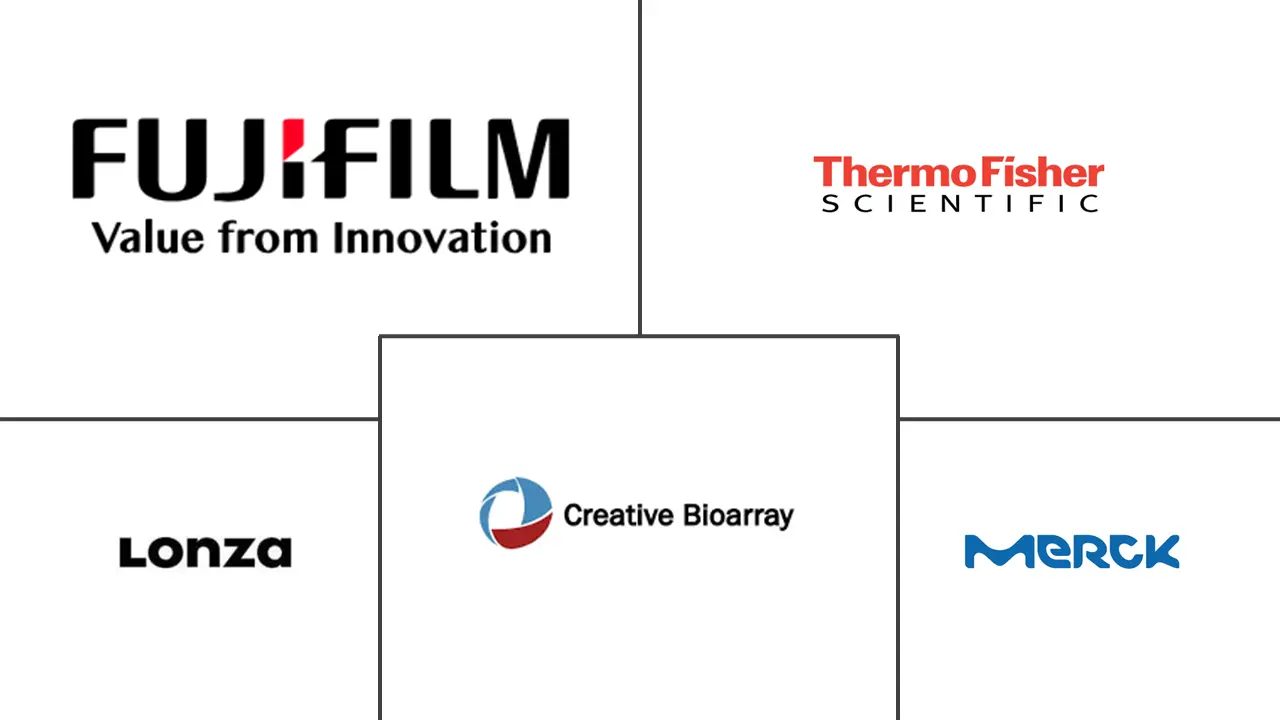Market Size of Cell Reprogramming Industry

| Study Period | 2019 - 2029 |
| Market Size (2024) | USD 367.44 Million |
| Market Size (2029) | USD 557.15 Million |
| CAGR (2024 - 2029) | 8.70 % |
| Fastest Growing Market | Asia Pacific |
| Largest Market | North America |
| Market Concentration | Medium |
Major Players
*Disclaimer: Major Players sorted in no particular order |
Cell Reprogramming Market Analysis
The Cell Reprogramming Market size is estimated at USD 367.44 million in 2024, and is expected to reach USD 557.15 million by 2029, growing at a CAGR of 8.70% during the forecast period (2024-2029).
The rapid rise in genetic disorders globally has strongly boosted the demand for research on cell reprogramming. Data from different regulatory bodies indicate the rising number of genetic disorders globally. According to April 2024 data from the European Commission’s EUROCAT, genetic anomalies were witnessed in 20.26 cases per 10,000 births in 2022, compared to 19.6 cases per 10,000 births in 2017 in Europe. Similarly, as per data from the Australian Institute of Health and Welfare (AIHW), 4,500 (or 1.7%) of Australian babies are born with congenital disabilities each year. The University of Michigan estimates that by 2040, amyotrophic lateral sclerosis (ALS) incidence will increase worldwide by 70%. With the rising population, the frequency of such defects is also rising, leading to the growing demand for research on cell reprogramming to treat human genetic and degenerative diseases such as Parkinson's disease or ALS. This is positively impacting market growth.
The increasing prevalence of chronic diseases, coupled with an aging population and increased technological advancement in the biotechnology field, is driving the growth of the cell reprogramming market. As populations age, there is a natural increase in the prevalence of chronic diseases, including cardiovascular and neurodegenerative disorders. Moreover, the aging process is intricately linked to cellular senescence, where cells experience irreversible growth arrest. For instance, in January 2024, researchers from New York’s Cold Spring Harbor Laboratory published a paper in the journal Nature Aging, which stated that the human body’s T cells can be reprogrammed to fight aging. The T cells can be used to fend off cells that increase as a person ages and cause inflammation, rendering the aging immune system less effective over time. Similarly, in January 2023, Rejuvenate Bio announced its preclinical research evaluating cellular reprogramming for age reversal, published in the preprint server bioRxiv. Such research on the applications of cell reprogramming is a primary driver of the market.
The cell reprogramming market has immense growth opportunities due to increasing strategic initiatives such as collaboration, launches, and other activities. For instance, in February 2024, Ginkgo Bioworks announced bit.bio as an inaugural partner of the Ginkgo Technology Network, an ecosystem of cutting-edge technology providers who will collaborate with Ginkgo to provide new, integrated R&D programs. Similarly, in May 2023, Mekonos announced its partnership with bit.bio for precision cell reprogramming technology to increase the development of human cells for research, next-generation cell therapies, and drug discovery. Such partnerships promote the application of cell reprogramming, driving market growth.
Technological advancements have substantially improved the efficiency and safety of inducing pluripotency in cells. Novel reprogramming factors and precise delivery methods contribute to increased efficacy, a critical factor for the scalability and practical implementation of cell reprogramming in diverse therapeutic contexts. These technologies enable precise and targeted genome modification, facilitating the development of disease-specific cellular models for research and drug discovery. For instance, in October 2023, Tenaya Therapeutics published preclinical data in circulation, highlighting the clinical potential of cell reprogramming for cardiac regeneration.
Market growth is also influenced by advancements in automation and robotics in cell manufacturing. Automated systems streamline the production of reprogrammed cells, ensuring consistency, scalability, and compliance with regulatory standards. For instance, in January 2023, Automata announced its partnership with bit.bio, to automate a vital aspect of the manufacturing process of iPSC (induced pluripotent stem cell)-derived human cell products.
Thus, the increasing prevalence of chronic diseases, coupled with an aging population and increasing technological advancement, is driving the growth of the cell reprogramming market.
Cell Reprogramming Industry Segmentation
As per the scope of the report, cell reprogramming is a process in which the identity and characteristics of differentiated cells are altered, typically by inducing the expression of specific genes or manipulating cellular factors. Cell reprogramming aims to convert a specialized cell, often somatic or differentiated, into another cell type.
The cell reprogramming market is segmented into technology, application, end user, and geography. The market is segmented by technology into Sendai virus reprogramming, episomal reprogramming, mRNA reprogramming, and other technology types. The market is segmented by application into research and therapeutics. By end user, the market is segmented into research & academic institutes and biotechnology & pharmaceutical companies. By geography, the market is segmented into North America, Europe, Asia-Pacific, and Rest of the World. The report also offers the market sizes and forecasts for 13 countries across the region. For each segment, the market sizing and forecasts were made on the basis of value (USD).
| By Technology | |
| Sendai Virus Reprogramming | |
| Episomal Reprogramming | |
| mRNA Reprogramming | |
| Other Technology Type |
| By Application | |
| Research | |
| Therapeutics |
| By End User | |
| Research & Academic Institutes | |
| Biotechnology & Pharmaceutical Companies |
| Geography | ||||||||
| ||||||||
| ||||||||
| ||||||||
| Rest of the World |
Cell Reprogramming Market Size Summary
The cell reprogramming market is poised for significant growth, driven by the increasing prevalence of genetic disorders and chronic diseases, alongside advancements in biotechnology. The demand for research in cell reprogramming is bolstered by the rising incidence of genetic anomalies and degenerative diseases such as Parkinson's and ALS, which necessitate innovative therapeutic approaches. The aging population further contributes to the market expansion, as age-related chronic conditions become more prevalent. Technological advancements in the field, including novel reprogramming factors and precise delivery methods, have enhanced the efficiency and safety of cell reprogramming, facilitating the development of disease-specific cellular models for research and drug discovery. Strategic collaborations and partnerships among key industry players are also fostering innovation and application in this domain, thereby driving market growth.
The mRNA reprogramming segment is expected to lead the market due to its versatile applications in manipulating cellular functions and its rapid, safe, and scalable nature. The success of mRNA technology, particularly highlighted by its role in vaccine development, has attracted substantial investments and interest from biopharmaceutical companies and research institutes. North America is anticipated to dominate the market, supported by significant investments in biotechnology and healthcare, as well as a robust research ecosystem. The region's well-established infrastructure and financial backing enable extensive R&D initiatives, promoting the exploration of cutting-edge technologies like mRNA-based cell reprogramming. The competitive landscape is semi-consolidated, with major players such as Thermo Fisher Scientific Inc., Merck KGaA, and FUJIFILM Corporation holding substantial market shares, further influencing the market dynamics.
Cell Reprogramming Market Size - Table of Contents
-
1. MARKET DYNAMICS
-
1.1 Market Overview
-
1.2 Market Drivers
-
1.2.1 Increasing Prevalence of Chronic Disease Coupled with Aging Population
-
1.2.2 Increased Technological Advancement in the Field of Biotechnology
-
-
1.3 Market Restraints
-
1.3.1 Adverse Effects Associated with Cell Reprogramming Technique
-
-
1.4 Porter's Five Force Analysis
-
1.4.1 Threat of New Entrants
-
1.4.2 Bargaining Power of Buyers/Consumers
-
1.4.3 Bargaining Power of Suppliers
-
1.4.4 Threat of Substitute Products
-
1.4.5 Intensity of Competitive Rivalry
-
-
-
2. MARKET SEGMENTATION (Market Size by Value - USD)
-
2.1 By Technology
-
2.1.1 Sendai Virus Reprogramming
-
2.1.2 Episomal Reprogramming
-
2.1.3 mRNA Reprogramming
-
2.1.4 Other Technology Type
-
-
2.2 By Application
-
2.2.1 Research
-
2.2.2 Therapeutics
-
-
2.3 By End User
-
2.3.1 Research & Academic Institutes
-
2.3.2 Biotechnology & Pharmaceutical Companies
-
-
2.4 Geography
-
2.4.1 North America
-
2.4.1.1 United States
-
2.4.1.2 Canada
-
2.4.1.3 Mexico
-
-
2.4.2 Europe
-
2.4.2.1 Germany
-
2.4.2.2 United Kingdom
-
2.4.2.3 France
-
2.4.2.4 Italy
-
2.4.2.5 Spain
-
2.4.2.6 Rest of Europe
-
-
2.4.3 Asia-Pacific
-
2.4.3.1 China
-
2.4.3.2 Japan
-
2.4.3.3 India
-
2.4.3.4 Australia
-
2.4.3.5 South Korea
-
2.4.3.6 Rest of Asia-Pacific
-
-
2.4.4 Rest of the World
-
-
Cell Reprogramming Market Size FAQs
How big is the Cell Reprogramming Market?
The Cell Reprogramming Market size is expected to reach USD 367.44 million in 2024 and grow at a CAGR of 8.70% to reach USD 557.15 million by 2029.
What is the current Cell Reprogramming Market size?
In 2024, the Cell Reprogramming Market size is expected to reach USD 367.44 million.

